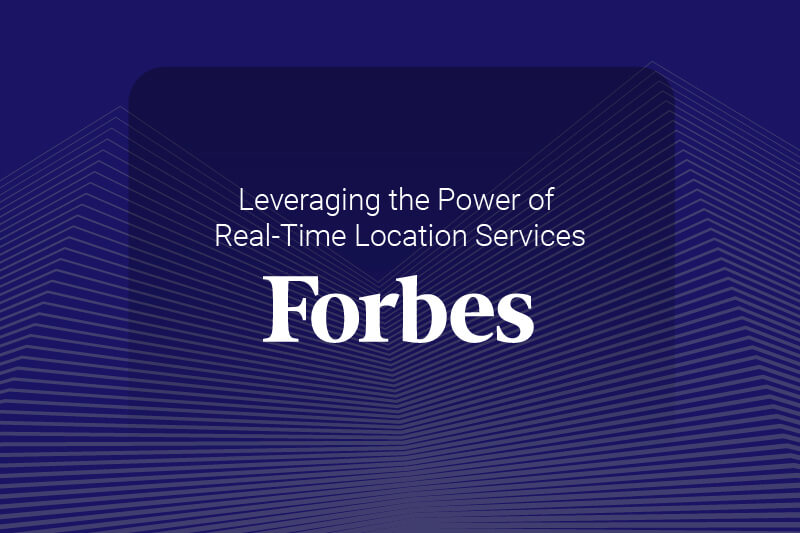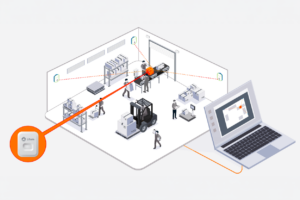As published on Forbes by Ozgur Ulku (19 April 2023)
Contents
These days, many people affix Bluetooth trackers, such as AirTags or SmartTags, to luggage, keys, wallets or even the inside of their cars to prevent theft or loss of high-value items. What they may not realize is that similar technology exists on an enterprise scale, and can be leveraged to prevent significant property damage, injury and even loss of life.
A quick primer on real-time location systems: These platforms, called RTLS for short, are indoor location systems that operate on a wireless mesh network, much like the wireless network in many people’s homes. Using a system of interlinked devices called anchors and gateways, and then tags on objects (individuals, assets, vehicles, etc.), RTLS allows a signal to be sent to the anchors, capturing location data on these objects and pushing that data to gateways, which are connected to a server. RTLS software platforms use that data signal to calculate the precise location of the object within an indoor environment, down to less than a meter. The technology is extremely precise and can be used in a wide range of indoor locations: examples include underground mining tunnels, subway stations, oil and gas refineries, warehouses, hospitals and elder-care centers. Effectively, it works like GPS (as far as most people experience it), but for indoor spaces only, and with a higher degree of sensitivity.
Some obvious use cases for this technology involve tracking the location of high-value objects in massive indoor spaces—say, trucks, shipping containers, trailers, expensive machinery, cash stores, rare minerals or stores of proprietary chemical compounds. However, RTLS is particularly applicable for protecting an organization’s most valuable asset: its people. If your company is just coming on board with RTLS, or has used it in the past but hasn’t maximized the investment, here’s how to deploy this technology across a range of industries:

Elder-Care Or Memory-Care Facilities
Implementing RTLS in dementia and Alzheimer’s care centers can be particularly impactful. Patients sometimes leave facilities (in many countries, they cannot be forcibly prohibited from doing so) and may then get lost, disoriented or have trouble finding their way back; they may also get into accidents or experience injuries, such as getting hit by cars or being stranded outdoors in dangerous weather. RTLS can issue an alert when the patient is approaching an exit gate so that, even if it is not legally possible to stop that individual from exiting the facility, a trained safety person or a security guard can then accompany that person, and eventually help bring them back to the facility.
Neonatal Wards
Hospital executives may have particular concerns about security in neonatal wards, which RTLS implementation can mitigate. In most hospitals, as soon as babies are born, they are affixed with a small tag—usually on their ankles—and the same type of tag goes on the wrist of the baby’s mother and any authorized medical staff. When this tag is enabled with RTLS, this links the pair in a way that strengthens and reinforces security protocols that most hospitals already have in place. For instance, if the wrong baby is then given to the wrong parent, the RTLS can issue an alarm or emergency notification. The same goes for a situation in which someone is transporting the baby without the proper authorization. When RTLS detects improper movement of the baby, the system can immediately trigger a lock on the elevators and doors and issue an alert for the security team to mobilize.
Emergency Rooms
Efficiency equates to life savings—the sooner a patient in an emergent situation receives care, the better their prognosis. Hospital systems can deploy RTLS in their emergency rooms to track the location of high-value medical assets like blood infusion pumps or MRI scanners so that there’s no question of where to find this item when needed quickly. This alone can improve the overall efficiency of asset utilization in a hospital setting.
However, in a more long-range view, healthcare executives can use data from RTLS to analyze patient and staff flow within any large facility. RTLS trackers can aggregate how much time it takes nurses to come and see patients for the first time, or how long they wait before being seen by the doctor. They can log how much time everyone spends walking through the hallways, waiting for encounters, tests, blood draws, or scans. And, they can detect where and when the bottlenecks happen. These data points can be leveraged to optimize these systems so that hospitals can provide the best quality care for their patients.
Supply Chain, Logistics And Warehousing
One significant concern within the warehousing industry is the prevalence of forklift collisions and related mishaps, which are an unfortunately common feature of warehouse operations—and these accidents are not only costly, as far as fixing or replacing damaged machinery, but dangerous to the employees working in these settings. Warehouse managers can use RTLS capabilities to leverage a collision warning system, such as installing a controller on the forklift and/or fitting employee pedestrians with tags. A safe zone can be set up within a millimeter level accuracy to detect when a forklift is getting too close to another forklift, to an employee, or to the end of an aisle; if danger is imminent, an alarm can sound, or the machinery can be slowed or shut down. Employing warning systems can significantly diminish the likelihood of these events, making RTLS an excellent tool for companies to leverage to reduce the potential for damage to machinery and bodily injury.
Mining And Tunnel Construction
Underground operations have many dangers associated with them, some of which RTLS can be impactful in mitigating. Mining and construction companies can implement RTLS in order to, quite literally, save the lives of their employees: For instance, if someone disappears underground, RTLS can show where that employee was last located. If employees are about to enter an area where toxic gas or other safety hazards have been detected, an alarm can go off, or access to these dangerous locations can be blocked. Similarly, there are certain confined spaces that can only accommodate a certain number of employees. RTLS can detect if these spaces are filled beyond capacity, which can present a safety issue in the event of a collapse, and trigger the relevant alarms and notifications.
RTLS is a fast-growing technology. However, there is still a lag in uptake in some industries. Cost is probably the most significant obstacle to implementation; this type of system requires financial outlay—not just for the technology itself, but to apply an effective change management protocol after a company “goes live,” enabling users to correctly engage with the system. In addition, RTLS is not “plug and play” and inherently comes with complicated parameters, software and hardware elements. The complexity of integrating existing system architecture and workflows with RTLS may inhibit some companies from adoption.
However, for those with the foresight and grit to weather the initial pain points of implementation, RTLS delivers a rapid and significant ROI, not only in preventing potentially catastrophic injuries or fatalities and expensive damage to machinery, but also in enabling systems to work at full strength, optimizing resources, space, manpower and equipment.




